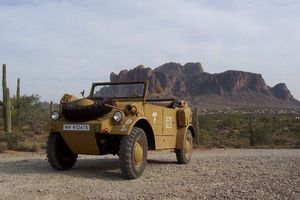.
Volkswagen Kübelwagen

| |
| Volkswagen Kübelwagen | |
|---|---|
| Volkswagen | |
| aka | Safari, Tub Car |
| Production | 1939-1943 50,435 units |
| Class | All-Terrain Vehicle Military Personnel Transporter |
| Body Style | Open body 1939 ~~ 1945 (52,000 Made by VOLKSWAGENS) |
| Length | {{{length - type here}}} |
| Width | {{{Width - type here}}} |
| Height | {{{Height - type here}}} |
| Wheelbase | {{{wheelbase - type here}}} |
| Weight | {{{Weight - you get the point}}} |
| Transmission | 4 speed manual |
| Engine | horizontally opposed 4 cylinder air cool 985cc 76.95.241.125 18:26, 31 May 2008 (UTC) 1131cc, 23.5hp 76.95.241.125 18:26, 31 May 2008 (UTC) 25hp |
| Power | 23.5-25 HP |
| Similar | {{{similar (competition)}}} |
| Designer | Ferdinand Porsche |
The Volkswagen Kübelwagen (bucket/tub car) was a military vehicle designed by Ferdinand Porsche and built by Volkswagen prior to and during World War II for use by the German military. It was known internally as the Type 62, then later as the Type 82 and based heavily on the Volkswagen Beetle. A later variant of the vehicle was released several decades after the war as the Volkswagen 181 for the Federal Geman Army and then for the civilian market Volkswagen 181 named "Thing" in the US, "Trekker" in the UK and "Safari" in Mexico.
History
In 1938 Adolf Hitler and several high ranking members of the Third Reich approached Ferdinand Porsche about designing an inexpensive, compact military transport vehicle that could be operated reliablly both on- and off-road in even the most extreme conditions, suggesting that the Beetle could provide the basis for such a vehicle.
Porsche began work on the project immediately, but realized during development that the Beetle's chassis was not capable of handling the stress that military use would put on it and sub-contracted Trutz to help make revisions to the platform. A prototype of the vehicle was ready within the month, designated as Type 62, and developmental testing by the military began in November. Despite lacking four wheel drive, a mainstay of the American military's Jeeps, the Type 62 proved very competent at manuvering its way over rough terrain and the project was largely lauded as a success. The light weight and ZF self lock diff compensate for the lack of 4X4 capabilities. Some later productions took the bigger engine and 4X4 drivetrain of the Schwimmwagen.
Despite their overall satisfaction with the vehicle's performance, military commanders demanded that a small list of changes be made, including re-styling the vehicle to give it a more aggressive appearance and further improving its off road ability. Porsche responded to both requests, and new axles, revised shocks, enlarged 16-inch wheels and a limited slip differential became part of the specifiaction; in order to reflect the changes, the vehicle was re-named Type 82.
The military took delivery of its first Type 82 Kübelwagen vehicles in December of 1939 and immediately put them to the test on- and off-road in snow and ice to test their capability at handling European winters; several four-wheel-drive vehicles were used as reference points. The Kübelwagen surprised even those who had been a part of its development, as it handily out-performed the other vehicles in nearly every test. In November of 1943, the American military conducted a series of tests as well on several Type 82's they had captured in North Africa; they concluded that the vehicle was simpler, easier to manufacture and maintain, faster, and more comfortable for four passengers than the American Jeeps.
Revisions were made again for 1943, including a revised dash and a new 1,131 CC motor producing more power than the original 985 CC unit. Prototype versions were assembled with four-wheel drive and different engines, but none offered a significant increase in performance or capability over the existing Type 82 and the designs were never used.
Volkswagen production ceased temporarily at the end of the war, but more than 55,000 Kübelwagen vehicles were produced during its production run and the vehicle had proved itself to be surprisingly useful, reliable and durable. VW resurrected the basic Kübelwagen design several years after they resumed production in post-war Wolfsburg as the Type 181.
In emergency, Britt postwar production started again in utility configuration, before the T2 combi.[1]
Other Information
A later Volkwswagen model was produced with a similar look and feel to the Kubelwagen. It was named the Type 181 (Volkswagen Thing in the United States).
Kübelwagen, is fully pronounced Kübelsitzwagen, AKA Bucket/Tub-seat-car
Images
See Also
External links
| Wikimedia Commons has media related to: |

